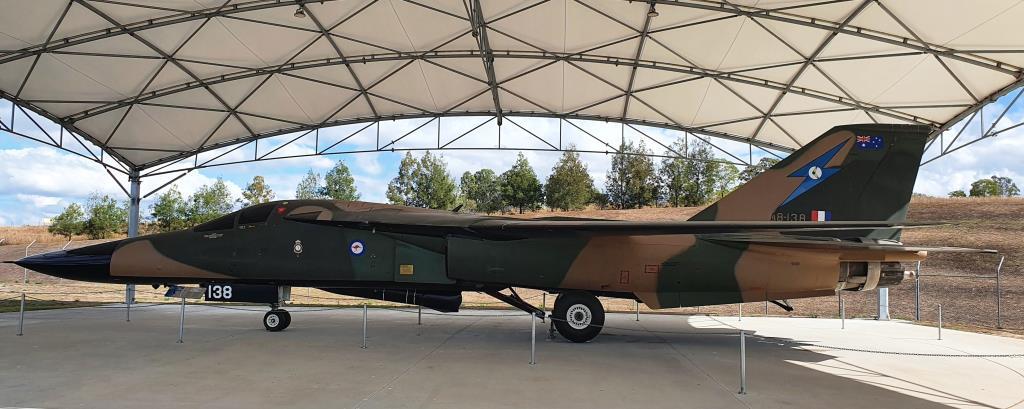
|
|
|
Privacy Policy | Editorial Policy | Profit Policy | Join the Association | List of Members | Contact us | Index | Links
Back Go to page: 1 2 3 4 5 6 7 8 9 10 11 12 13 14 15 16 17 18 19 20 Forward
Contents:
Unlike most British Commonwealth countries, Australia decided at the end of the 1939-45 war, to disband all its women's forces except the nursing services, but less than three years after the last of the WAAAF were demobilized in 1947, an announcement was made to Parliament by the Governor-General in February 1950, intimating the Government's intention to re-introduce a Women's Auxiliary Air Force.
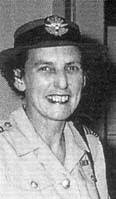
In July 1950, Cabinet approved the re-establishment of a women's air force in principle and in August came recognition that women were essential components of the armed forces, in peace and war. No longer an Auxiliary, the proposed new Service was regarded as a Branch of the PAF and was known as the Woman’s Australian Air Force ( WAAF). In November 1950, the Minister for Air announced that a further honour had been paid to Australian servicewomen by His Majesty, King George VI, who had approved the adoption of the title ' Women's Royal Australian Air Force'.
The first recruits began training on 30 January 1951, with Wing Officer Doris Carter (right) as the service's director. She retired from the post in 1960 and was succeeded by Group Officer Lois Pitman followed by Group Officer Dawn Parsloe in 1972.
Doris Jessie Carter OBE (5 January 1912 – 28 July 1999) was prominent with the Women's Auxiliary Australian Air Force during the Second World War. She was an athlete who specialised in the high jump and was the first Australian female track and field athlete to make an Olympic Games final. She was placed 6th in the 1936 Olympics in Berlin and also competed in the 1938 British Empire Games in Sydney. She won five National Championships at high jump (1933, 1935, 1936, 1938, 1940) and two at discus throw (1936, 1940) in her career. After her competitive career, she became involved in the administration of women's athletics both at State and National levels. In 1956 she was the Assistant Manager to the Australian Olympic Team during the Melbourne Olympic Games.
Carter co-lead the Anzac Day Parade at Melbourne in the mid 1990s.
The initial size of the WRAAF (pronounced WAF) was limited to an establishment of 30 officers and 832 airwomen who were to form a well-trained nucleus which could be quickly and efficiently expanded in an emergency. From the very beginning, members were to engage in productive duties to ease acute shortages of staff in certain trades (eg, clerical and signals musterings) and release members of the RAAF for other work.
In 1951, it was decided to grant officers short service commissions only, which might be extended for a period not exceeding three years, while airwomen were to be enlisted for four years with an opportunity to re-engage for further similar periods. In 1956, airwomen were permitted to re-engage for a shorter period of 2 years, if desired.
In 1965 the WRAAF ceiling establishment was raised to 1050.
WRAAF Uniforms - early days.
It had been an early intention to let the Service grow slowly and limit initial recruiting mainly to ex-Servicewomen already trained in skilled musterings. Enlistments were delayed while Treasury sorted out problems involving relations between the three women's services, but there was no lack of interest. Scores of enquiries had been received by July 1950 and by October, more than 2000 women had applied to join the WRAAF.
The first group of applicants were x-rayed and aptitude tested at Laverton on 12 December 1950. On 30 January 1951 (the date accepted as the WRAAF Birthday) 16 trainees from Victoria and seven from South Australian commenced No. 1 Recruit Course at Laverton. On the same day 27 recruits from NSW began No. 2 Course at Richmond. Other recruit courses followed in quick succession and training was also conducted at Point Cook and Pearce.
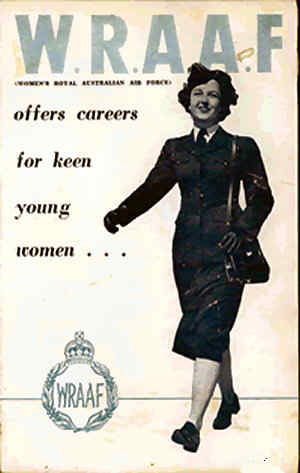
Courses were later confined to Richmond and Laverton. Training ceased at Richmond and Laverton in 1952 and 1953 respectively and under the new Command structure WRAAF Recruit Training was transferred to Point Cook. In 1965 the WRAAF Recruit Training Section became a squadron of 1 RTU at RAAF Edinburgh.
Courses for recruits were increased from 4½ weeks to 5 weeks in 1970.
In 1950 uniforms were designed for the WRAAF by the Commonwealth Government Clothing Factory in consultation with Miss Rita Findlay, a Director of Georges' Ltd Melbourne, and despite a certain amount of criticism, these uniforms were a big advance on wartime WAAAF issue. The summer dress, a blue grey rayon long sleeved frock was quite a change from the old khaki drill shirt and skirt. A blue forage cap with light blue piping replaced the peaked cap of the WRAAF winter uniform, the new jacket was fitted to be worn without a belt, and a box pleat was added to the navy skirt. Minor but popular additions to the uniform comprised a black leather sling shoulder bag, black (instead of tan) gloves and nylons. Permission to fold handbag strap and carry the handbag over the wrist was given in 1960.
Despite the attention given to equipment all difficulties were not foreseen, eg, the size rolls for uniforms were originally copies from those used for the manufacture of women's garments by a large city firm. Needless to say, such a firm catered for an age range extending far beyond that at which women were likely to be serving in the forces, but this was not taken into account when WRAAF uniforms were ordered.
The arrival of raincoats from the United Kingdom caused further consternation. These had been made to wartime specifications and it was forgotten that post-war fashion had decreed a lengthened hemline. Nevertheless, at least the essential minimum of clothing was ready in time and the new style, an initial clothing allowance of £10 (now $42) and the expectation of WRAAF attache and suitcases, made prospects reasonably bright.
A new type of dual-purpose coat, a double breasted gaberdine with a detachable inner half-lining, was received early in 1954 and about the same time, the WRAAF, together with the RAAF, changed their black buttons. The blue-grey long sleeved summer uniform was replaced in 1956 by a blue-white short sleeved frock. WRAAF were permitted to purchase nylon raincoats on repayment in 1962, but raincoats were not brought onto the Scale of Issue.
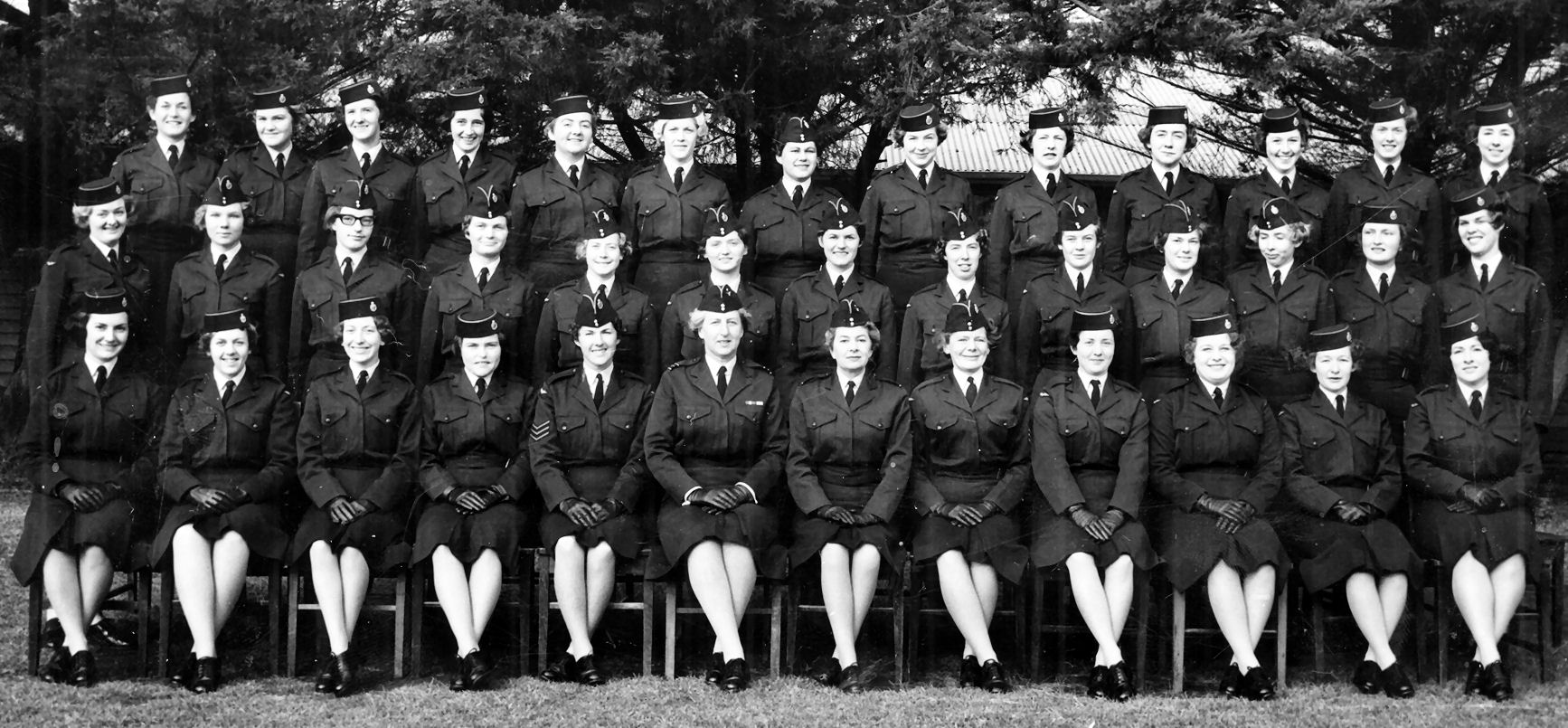
The uniform was revised again in 1962 and major changes suggested. Recommendations were made for new styled hats, overalls as a two-piece garment, alterations to Dress 1A and permission to carry umbrellas and to wear high heeled shoes off the unit and on certain informal occasions. These recommendations were approved in 1963, and issues were made progressively as old stocks were used up. A major revision and updating of uniform was approved in December 1972.
Conditions of service for WRAAF are similar to those for airmen but an airwoman's pay was considerably less than the male rate in the early days. The Allison committee in 1958 determined WRAAF rates of pay as:
-
75% basic wage,
-
66⅔% male margin for rank,
-
100% male margin for skill,
-
plus a special service loading and uniform allowance minus a clothing saving deduction and value of rations and quarters.
The National Wage Case of 1969 established the principle of the gradual introduction of equal pay for identical work. In 1970 this principle was applied to airwomen who, in step with female civilians, gradually achieved 100% of the basic wage by 1972. NCOs, however, received only 66 2/3 of the male margin granted for rank, which increased to 80% in 1971.
WRAAF officers prior to 1970 received between 66⅔% and 68% of male officer rates. This percentage was increased to 76-78% from December 1970.
A change in policy in 1969 permitted a member of the WRAAF to continue serving after marriage if she:
-
elected before marriage, to do so;
-
undertook to meet in full the normal service requirements expected of unmarried members; and
-
continued to meet in full those requirements.
In 1972, the service achieved a pay scale equal to the male service and in 1977, the WRAAF was absorbed into the RAAF.
The Definition of:
A Committee. A body that keeps minutes and wastes hours.
Mirage to Townsville.
Mike Downs, who is a WO with the History and Heritage Branch at Amberley, says the Air Force's Static Display Aircraft Support Section (SDASS) has moved Mirage A3-55 from RAAF Amberley to RAAF Townsville. The journey began on Friday (31 Jul) at mid-night. The trip took 3 days, arriving at Townsville at 2.00pm on Sunday (02 Aug). The Mirage arrival was planned to coincide with the arrival of Winjeel A85-403 which travelled as an independent package, also from Amberley.
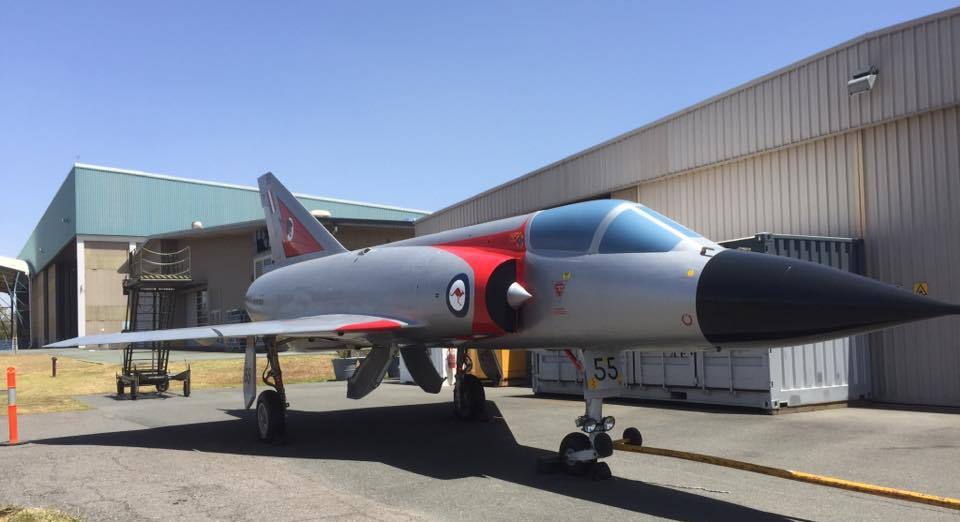
Planned route for the Mirage, which arrived without a hitch, was:
Fri:
Amberley, Toowoomba Bypass, Dalby, Miles, Wandoan, Taroom, Banana (o’nite stop)
Sat:
Banana, Dululu, Dingo, Moranbah (o’nite stop)
Sun:
Moranbah, Belyando Xing, Charters Towers, Townsville.
The package was 8.2 metres wide so it was hard to avoid. Channel 10 showed it on their nightly news, if you missed it you can see it HERE.
Channel 7 had it too, see below.
Lady F-111 ers
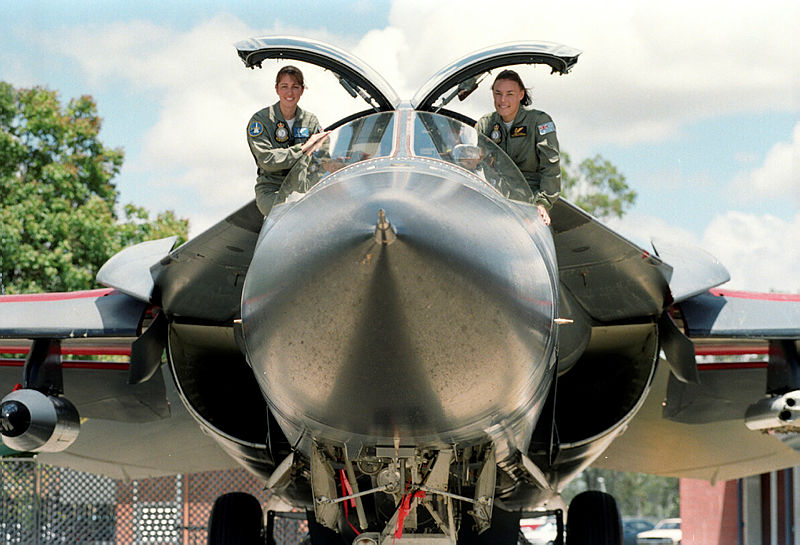
Brooke Chivers and Aroha Fifield, the first female F-111 aircrew are pictured in the hot seat of their F-111 aircraft on the flight line at Amberley.
In 2000, The Minister Assisting the Minister for Defence, Bruce Scott, advised that two women had completed an intensive training course to become the first female officers in the Air Force to graduate to fast jets.
Mr Scott said the women’s graduation as F111 navigators signalled a major milestone for the RAAF and the opportunities now available to females in today’s modern Defence Force. He said the two women should be very proud of their status within the RAAF’s aircrews as fast Jet training was the most difficult in military aviation.
"Flying Officer Chivers, Pilot Officer Fifield and their four male colleagues from this latest F 111 conversion course face a major responsibility flying the F 111 strike aircraft and join a dedicated and professional team at Amberley which fly, maintain and support these high-tech aircraft, he said.
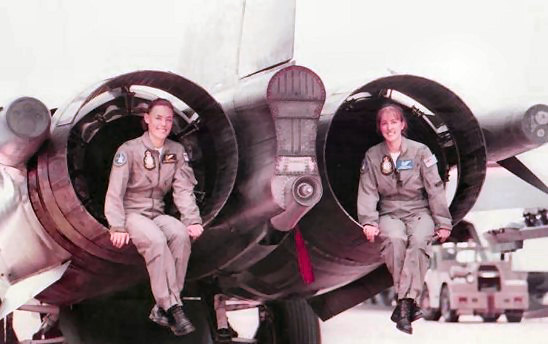
Flying Officer Brooke Chivers (left) and Pilot Officer Aroha Fifield had earned their brevets as navigators in the RAAF’s frontline F 111 squadrons at Amberley. Here in the hot end!
This milestone illustrates the many opportunities available to women in the Australian Defence Force and their increasingly important contribution to the Servrces. In fact, only a few months ago another woman, Air Commodore Julie Hammer, became the first female officer to be promoted to an "air" rank in the history of the RAAF and a one star general in the ADF.
Mr Scott said although the ADE had had female pilots and navigators for several years, this was the first time women had joined what is termed the ‘fast jet’ stream of military aviation in the ADF. He said more women were showing interest in a flying career with the Defence Force and there were now about 25 female pilots and navigators in the ADF with another dozen in training.
Inflation. Cutting money in half without damaging the paper.
Flying the F-111.
Mike Gaines
The RAAF aircrew call the F-111 “The Pig”, not because of any adverse handling characteristics, but because it has a long snout which spends a lot of its time snuffling along close to the ground. The first thing I note on climbing into the F-111 is the view over the long nose, which sticks out way ahead of a very deep instrument coaming. The bottom edge of the curved windshield is about two yards ahead of me, so the view down and ahead is cut off. As F-111 instructor Flt Lt “Boomer” Taylor explains, “That’s no problem with the Pave Tack, the nav can look ahead on that, but with this [an RF-111B] we have a closed-circuit TV camera just aft of the nose-gear so we can line up on the target. At high level the nose blocks the view of the ground ahead for about 20 n.m.”
As we taxi out, I put our target co-ordinates into the archaic INS, which is a real pain to use. Boomer reads out the lats and longs. “OK, that’s North 48 …, “I say. “No, mate, South. We don’t have that much fuel,” says Boomer. Red-faced, I crank in the numbers. You twist a spring-loaded knob, and the co-ordinate numerals click around on their drums. The harder you twist, the faster they go. Twist one way to increase, the other way to decrease. The system can store three destinations, to use as way-points. It is time consuming and laborious enough to do while taxying; later I’ll find what a pain it can be.
We pull up into a max angle climb from the runway at 9 alpha and 190 kt. Boomer eases the wings back to 26 degrees as we swing east to overfly Brisbane at 15,000 ft, checking out the automatic terrain following (ATF) systems. We obtain clearance into the supersonic low-level corridor as we complete the checks with 200 ft on the Set Clearance Plane and select “Hard” on the “Soft/Medium/Hard” ride selector. The last check is to see that the fail-safe auto-pull-up works. Any faults in the ATF chain and the aircraft will pull up at 3g.
Terrain following.
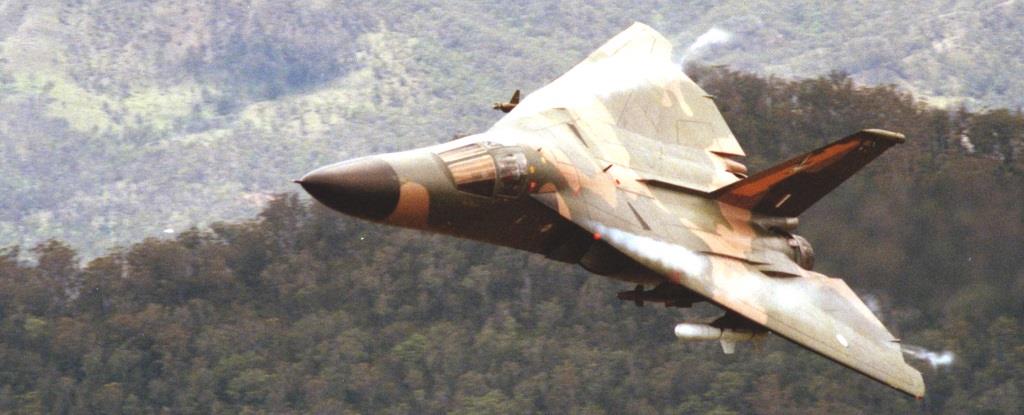
“OK, all ready? Let’s go down,” says Boomer, engaging the ATF and pulling the wings back. The nose pitches down, hesitates, and pitches down again, Boomer is sitting with his hands on his knees as we descend rapidly. At 1,000ft the nose starts pitching up, giving us 2g until we are straight and level at 200 ft. “Now watch this.” The noise levers go forward and the wing sweeps even further back as the afterburners kick in. The sea rushes past, and as we go supersonic there is just the slightest tremor. Boomer hand flies us down to 100 ft and Mach 1.2. The sensation of speed is fantastic.
I look in the mirror: behind us a ball of spray erupts from the sea where our shock wave hits. But what really sticks in my mind are the fuel flow gauges. In full afterburner the left engine drinks 52,500 lb/hr and the right 62,500 lb/hr, with the turbine inlet temperatures hovering around 1,100 degrees C. Taking a glove off, I note that the canopy getting hot to the touch. We maintain this dash for a minute or so before pulling up and slowing to a pedestrian 200ft/540kt.
Auto-toss.
We carry out a laydown attack on Snapper Point range, then swing around south for a 270 degree turn to head north for a Pave Tack auto-toss profile demonstration. After the 3g pull-up and release Boomer racks it around in a 4g manoeuvre designed to allow the Pave Tack to continue lazing the target as we escape at low level back to the south. “Now let’s update the nav kit,'' he says, reeling off a string of numbers for me to tweak into the “Present Position” number cruncher.
This is not so easy, because Boomer is pulling us hard round to cross over the centre target on the range, whose co-ordinates I am desperately trying to feed while fighting the g, avoiding the stick, and trying to keep my head up. It really is a pain compared with the modern systems I have used before. I get the numbers in and press the “Fix” button as we cross the target. The kit declines to accept it, so we turn hard and overfly again. This time it goes in, and the INS is updated.
We head inland towards the Great Dividing Range for some low flying. The terrain-following radar has a narrow beam width, so in Auto TF the aircraft often passes extremely close to high terrain on either side. Auto TF is usually a night/bad weather option. In daylight the pilots prefer to fly the TF, following pitch demand bars on the AHI and keeping an eye out ahead. Using the AHI will give the lowest terrain clearance (set in multiples of 200 ft) for the ride quality selected: soft, medium, or hard. We select 200 ft, hard ride, and bat along at Mach 0.9.
There are problems with that, so we decide to do Auto TF. The system takes over, and Boomer sits back with his hands on his knees. “Pretty good, eh?” I am watching a hill dead ahead. “What? Oh … er… yes.” The Auto TF pulls us up and, as we start to clear the ridge, pushes us down again. In hard ride it is a -g push which lasts for several seconds and is absolutely delightful.
Approaching the next ridge Boomer removes a glove. As we unload to 0g again he tosses it into the air, where it floats gently backwards until the g comes back on to position us in a valley. “In hard ride the system leaves it later for the pull-up, to keep our exposure time down as we cross the ridge. At night I would monitor the E-Scope TF presentation and the nav looks at his attack radar display for terrain avoidance in azimuth. Look how close we are to this feature ahead and you will see what I mean about the narrow TF beamwidth”. A small mountain slides past very close. “Good thing about night flying; you don’t see them,” laughs Boomer, “but we would like a moving map display so we can better plan our terrain avoidance, I doubt if we will get it, though.”
Reducing the workload.
After ten minutes, I am totally confident in the Auto TF and feel at ease. We are chatting unconcernedly about what we are going to do next, and we are free to keep an excellent lookout all round. In short, the Auto TF leaves the crew free to think tactics and keep ahead of the game.
With a digital nav attack system the workload in the right-hand seat will be much lower, and the overall system accuracy will be much improved. Old the F-111 may be, but the digital update will rejuvenate it.
Pave Tack
We've all seen that "thing" that hangs out the bottom of the F-111, that "thing" that looks like a bit like a bomb, but who knows what it is?
It is of course the Pave Tack and is a device that was designed and built by Ford. But, apart from being Radtech's magic, what is it and what does it do.
Click the pic below to see.
110 RTC
15 August 1977 – 15 December 1978
Allan Threadgate sent us this. If you've got as Course photo that we don't have HERE - please get it to us.
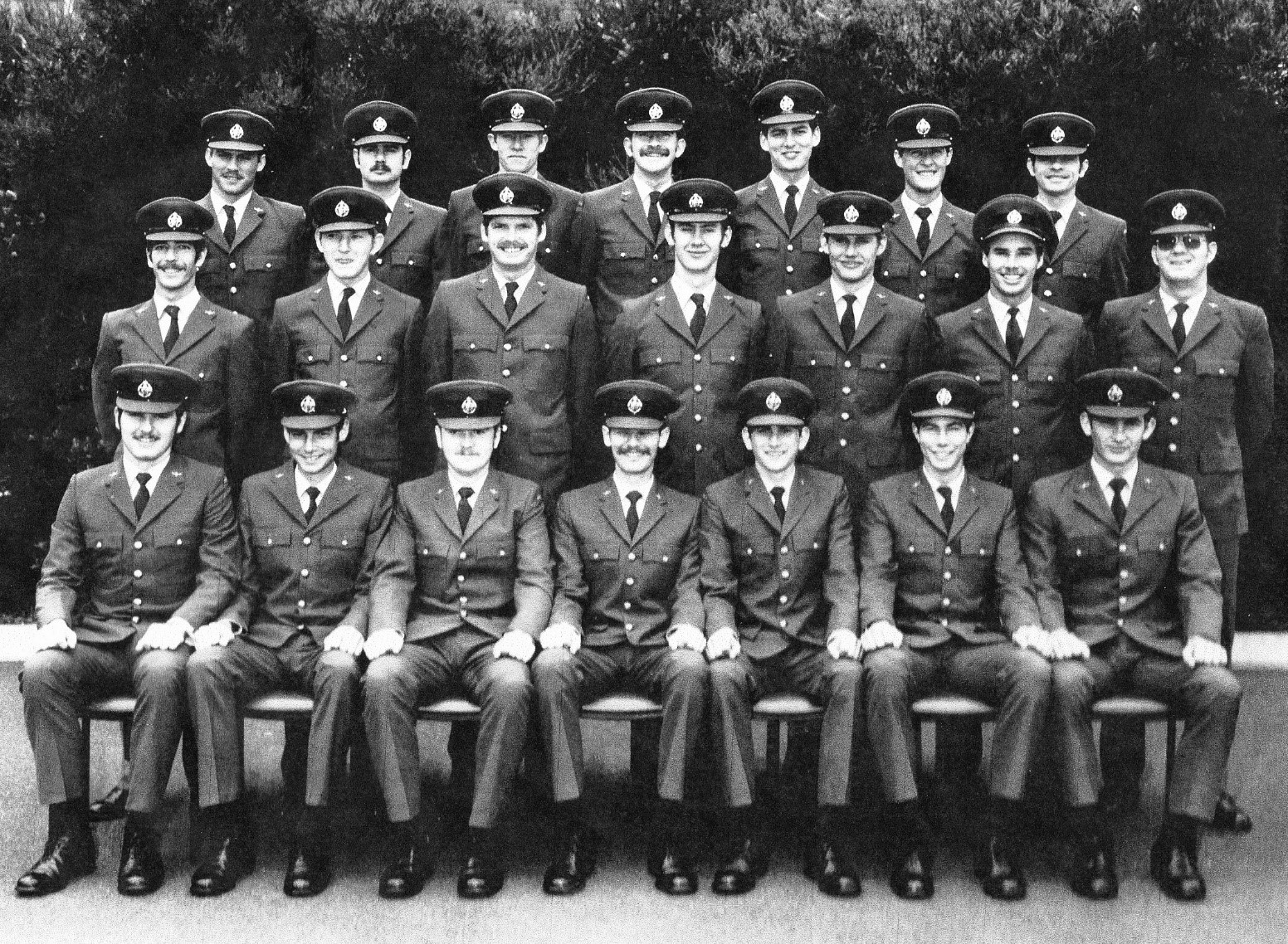
Back Row L-R: Allan Rowley, Guy Hickey, Phil van Dyke, Unknown, Rory O’Conner, Wolfgang Wynd , Mick Fawcett.
Middle Row L-R: “Gumby” Morris, Michael Corliss, Allan Threadgate, Chris Ollsen, Dan Andersen, Scott Coyne, Greg Lakeman.
Front Row L-R: Michael Cowell, Des Boorman, Russel Marriot, Graham Wood, Greg Abbott, Bill Rowland, Michael Tracey.
Skeleton A bunch of bones with the person scraped off.
Hitchhiking snake.
Back in 1970, the blokes at 9 Sqn in Vung Tau got quite a shock when they discovered a large snake in their aircraft. Not being the bravest of blokes, no-one volunteered to hop into the aircraft to get it out so they came up with a “weird” way of getting rid of the it. They gaffer taped up the aircraft, backed up the CO’s jeep, hooked up a hose from the Jeep’s exhaust to the inside of the aircraft, started the jeep and pumped CO into the Aircraft – in an attempt to kill the snake.
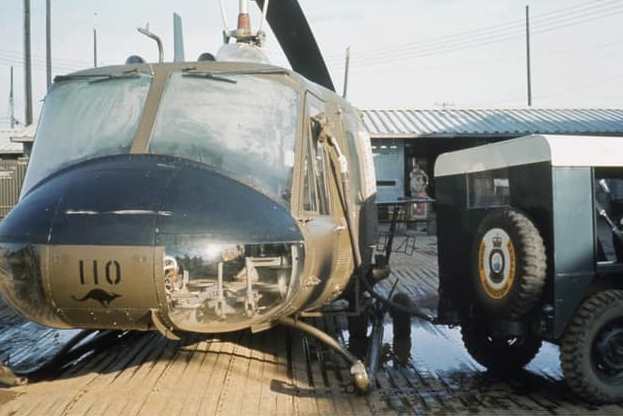
Much to the amusement of the local Vietnamese people.
The snake, being a lot smarter than the average 9 Sqn bod, just crawled up into the tail boom and settled in.
Of course, this “scientific” method didn’t work, and while the 9 Squadroners retreated to the hangar to contemplate their next intelligent move, one of the local Vietnamese hangar workers just crawled into the aircraft, grabbed the snake and got rid of it.
Yawn An honest opinion openly expressed.
9 Squadron “People Sniffer”.
9 Squadron chopper being prepared for a "People Sniffer" mission at Kanga Pad at Nui Dat. The "People Sniffer" or Airborne Personnel Detector Mk3 was a device for detecting by scent the presence of humans on the ground beneath the aircraft, as it flew at treetop level.
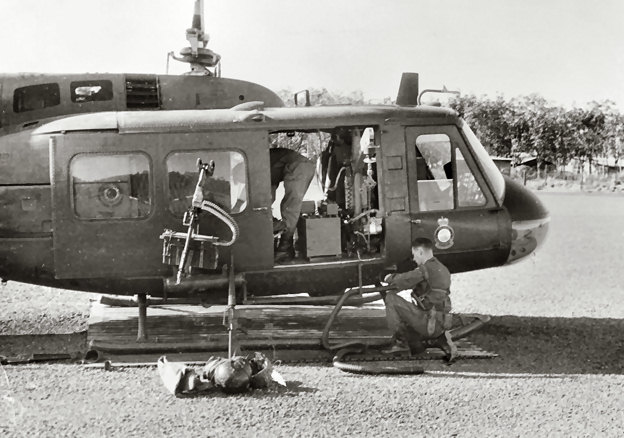
Warrant Officer 2 Trent Keary, Air Intelligence Section, Detachment 1 Division Intelligence Unit, 1ATF, is attaching the air sample probe for the "People Sniffer" to the skid of the helicopter. The major components of the device consisting of a large metal box with smaller boxes on top of it are visible in the doorway of the aircraft.
Wrinkles Something other people have.
A2-1022 being rebuilt.
AWM Photos
On the 11 May 1967, 9 Sqn B model helicopter A2-1022 had an engine failure shortly after take-off, crashed and was extensively damaged. The engine failure, due to grass being ingested through the engine's air inlets, was one of a spate that occurred around this time. A second helicopter (A2-1019, now in the AWM's collection) crashed in similar circumstances on the 13th April 1967 at Vung Tau.
Earlier, A2-1022 been involved in an heroic supply drop of ammunition to the besieged D Company, 6th Battalion at Long Tan. It was, at that time, flown by F/L Cliff Dohle.
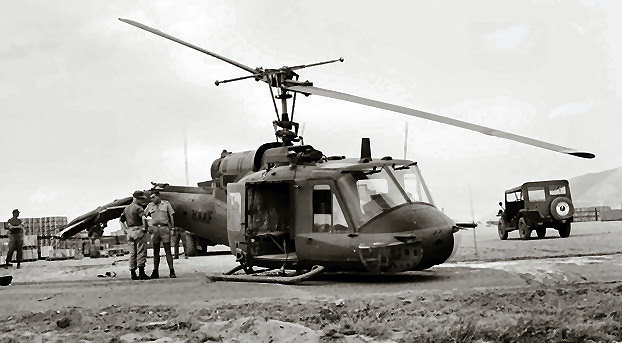
After the 1967 crash, the airframe was carried back to Vung Tau and deposited in the ammunition dump at Vung Tau. It was then moved into the hangar where 9 Sqn bods got stuck in and rebuilt it.
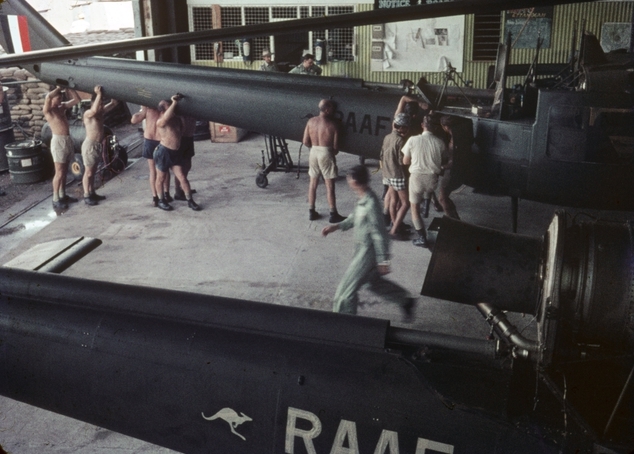
We tend to do that, whereas the US would just scrap it and grab another one from the manufacturer, we spend countless hours and parts (and dollars) rebuilding broken aircraft.
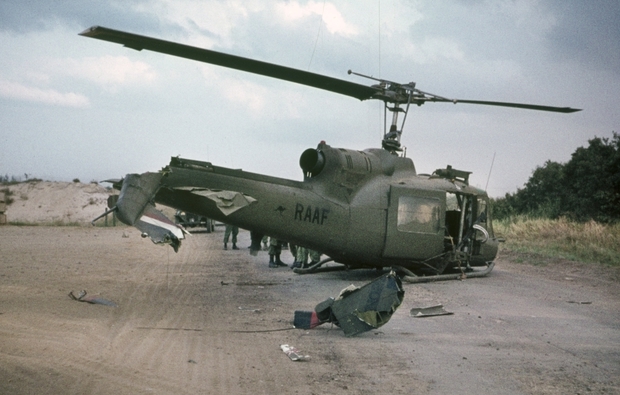
Good training for all the blokes, but it means the flight line is down one aircraft for months.
But people far smarter than me make these decisions – so that’s the way it is.
On the 8th December, 1971 the Iroquois and personnel of 9 Squadron were loaded onto HMAS Sydney for the trip home. Rarely numbering more than 16 airframes the Sqn flew a total of 58,768 hours on 237,806 sorties over the course of their five year deployment with an average serviceability rate of 84.05 per cent. It carried 414,818 passengers, 12,207 tonnes in freight and dusted off 4,357 personnel. It fired off 15,512,361 7.62mm rounds and 29,285 rockets.
An outstanding effort by both air and ground crew demonstrating the RAAF’s ability to mount and sustain its rotary wing capability in the most extreme of operational environments. During the war, the Squadron lost 6 of its members with a further 8 being injured. It also lost 7 aircraft and a further 23 suffered battle damage.
After returning to Australia, A2-1022 had another accident, crashing with destructive engine failure over Hornsby (NSW) and crash landed onto a football oval in the late 70's (possibly 1977). The Pilot was F/L Kevin Barrington and the aircraft was carrying VIP pax at the time. There were no injuries and 2AD at Richmond eventually rebuilt the airframe. It then went to Pearce where it crashed again on the 29th May 1984. The airframe was returned to Laverton where it was rebuilt as a training aid, then gifted to Nyngan in NSW in recognition of the RAAF's work in support of the community during the Nyngan Floods. In 2011 it was transported by road to Caloundra for restoration at the Queensland Air Museum then put on display at the local RSL. (See HERE).
It was removed from the pole at the RSL in 2018 to play itself in a movie about the Battle of Long Tan, given a spruce up and returned to the pole.
Post-Vietnam: From 1976 to 1986, personnel and aircraft were provided for United Nations and other multi-national peacekeeping operations in the Middle East. The Squadron began re-equipping with Blackhawk helicopters in 1988 preceding transfer of aircraft assets to Australian Army Aviation and disbandment of the Squadron in February 1989.
April Fools day was cancelled this year as no made up prank
could match the unbelievable crap happening in the real world right now.
Breakfasting 18 July 2020.
Spotted in one of Brisbane's great little nosheries, enjoying a hearty breakfast, were this bunch of lads with their ladies.
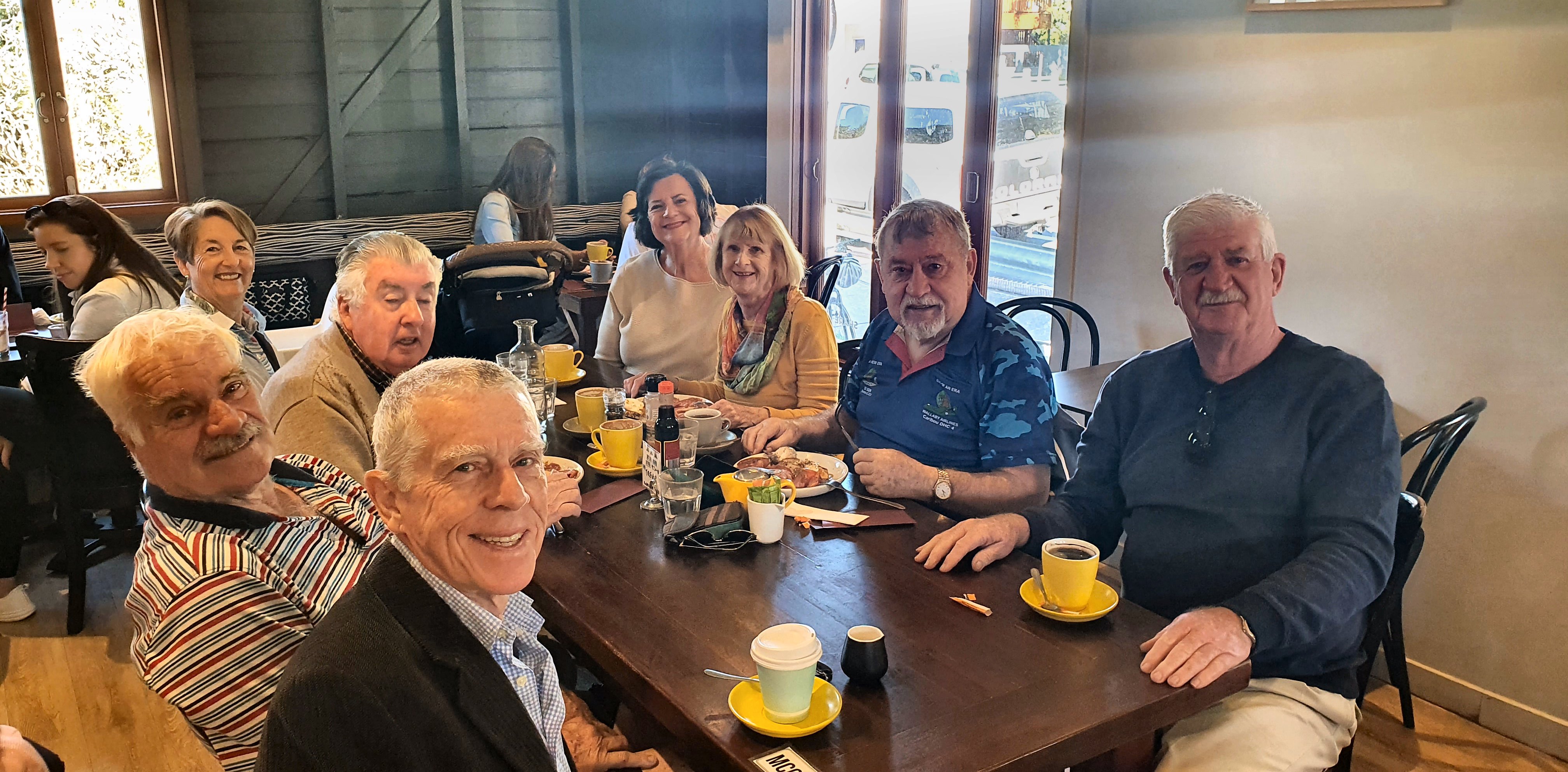
Clockwise from 7 o'clock: David Muir-McCarey, John Broughton, John McDougall, Sue Muir-McCarey, Sheryl Benneworth, Sue McDougall, Ted (RAAF’s 2nd best Radtech) McEvoy, Trev (Radtech extraordinaire) Benneworth.
Back Go to page: 1 2 3 4 5 6 7 8 9 10 11 12 13 14 15 16 17 18 19 20 Forward
